Business Strategy Report: KPMG Competitive Advantage Analysis
VerifiedAdded on 2023/06/08
|15
|4425
|336
Report
AI Summary
This report provides a comprehensive business strategy analysis of KPMG, a multinational professional services network. It begins with an introduction to business strategy and the specific context of KPMG, then proceeds to a detailed examination of both internal and external factors influencing the company. Part A includes a SWOT and PESTLE analysis, an assessment of KPMG's capabilities and resources, a competitive analysis using Porter's Five Forces model, identification of competitive advantages, and the formulation of tactical objectives and strategies. Part B focuses on evaluating strategic options, recommending growth strategies, and assessing methods for monitoring the success of chosen strategies. The report concludes with a summary of findings and recommendations, supported by relevant references, offering insights into KPMG's strategic positioning and future growth prospects.
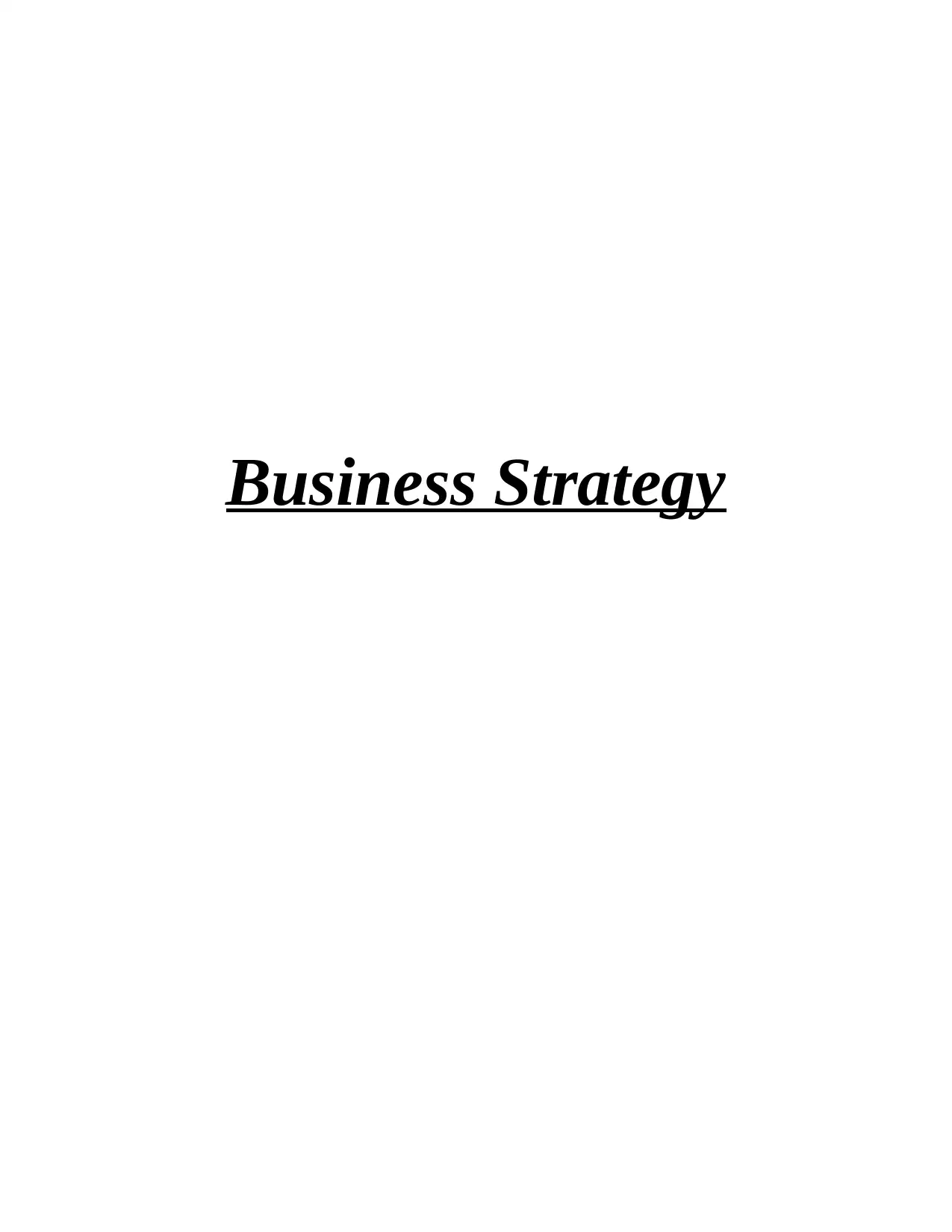
Business Strategy
Paraphrase This Document
Need a fresh take? Get an instant paraphrase of this document with our AI Paraphraser
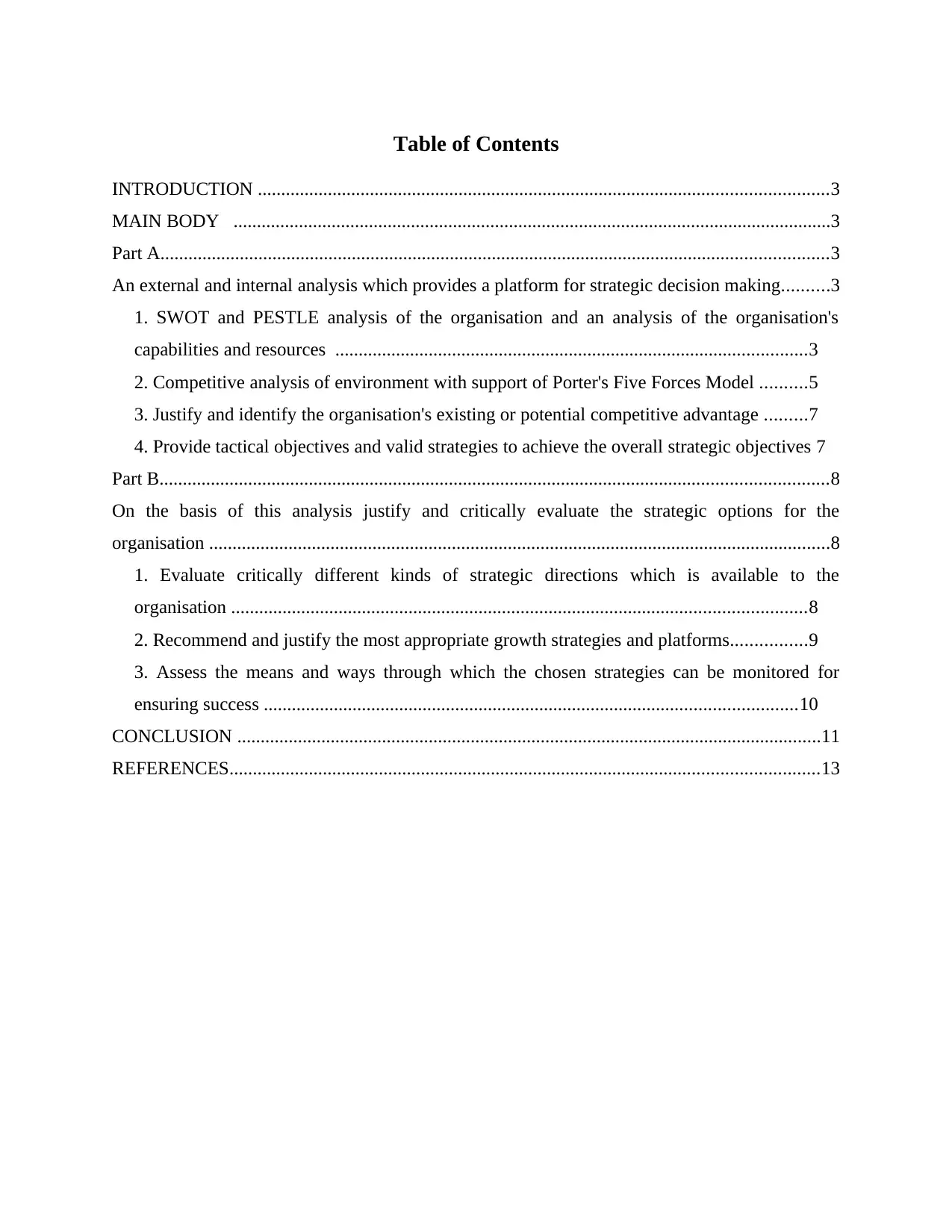
Table of Contents
INTRODUCTION ..........................................................................................................................3
MAIN BODY ................................................................................................................................3
Part A...............................................................................................................................................3
An external and internal analysis which provides a platform for strategic decision making..........3
1. SWOT and PESTLE analysis of the organisation and an analysis of the organisation's
capabilities and resources .....................................................................................................3
2. Competitive analysis of environment with support of Porter's Five Forces Model ..........5
3. Justify and identify the organisation's existing or potential competitive advantage .........7
4. Provide tactical objectives and valid strategies to achieve the overall strategic objectives 7
Part B...............................................................................................................................................8
On the basis of this analysis justify and critically evaluate the strategic options for the
organisation .....................................................................................................................................8
1. Evaluate critically different kinds of strategic directions which is available to the
organisation ...........................................................................................................................8
2. Recommend and justify the most appropriate growth strategies and platforms................9
3. Assess the means and ways through which the chosen strategies can be monitored for
ensuring success ..................................................................................................................10
CONCLUSION .............................................................................................................................11
REFERENCES..............................................................................................................................13
INTRODUCTION ..........................................................................................................................3
MAIN BODY ................................................................................................................................3
Part A...............................................................................................................................................3
An external and internal analysis which provides a platform for strategic decision making..........3
1. SWOT and PESTLE analysis of the organisation and an analysis of the organisation's
capabilities and resources .....................................................................................................3
2. Competitive analysis of environment with support of Porter's Five Forces Model ..........5
3. Justify and identify the organisation's existing or potential competitive advantage .........7
4. Provide tactical objectives and valid strategies to achieve the overall strategic objectives 7
Part B...............................................................................................................................................8
On the basis of this analysis justify and critically evaluate the strategic options for the
organisation .....................................................................................................................................8
1. Evaluate critically different kinds of strategic directions which is available to the
organisation ...........................................................................................................................8
2. Recommend and justify the most appropriate growth strategies and platforms................9
3. Assess the means and ways through which the chosen strategies can be monitored for
ensuring success ..................................................................................................................10
CONCLUSION .............................................................................................................................11
REFERENCES..............................................................................................................................13
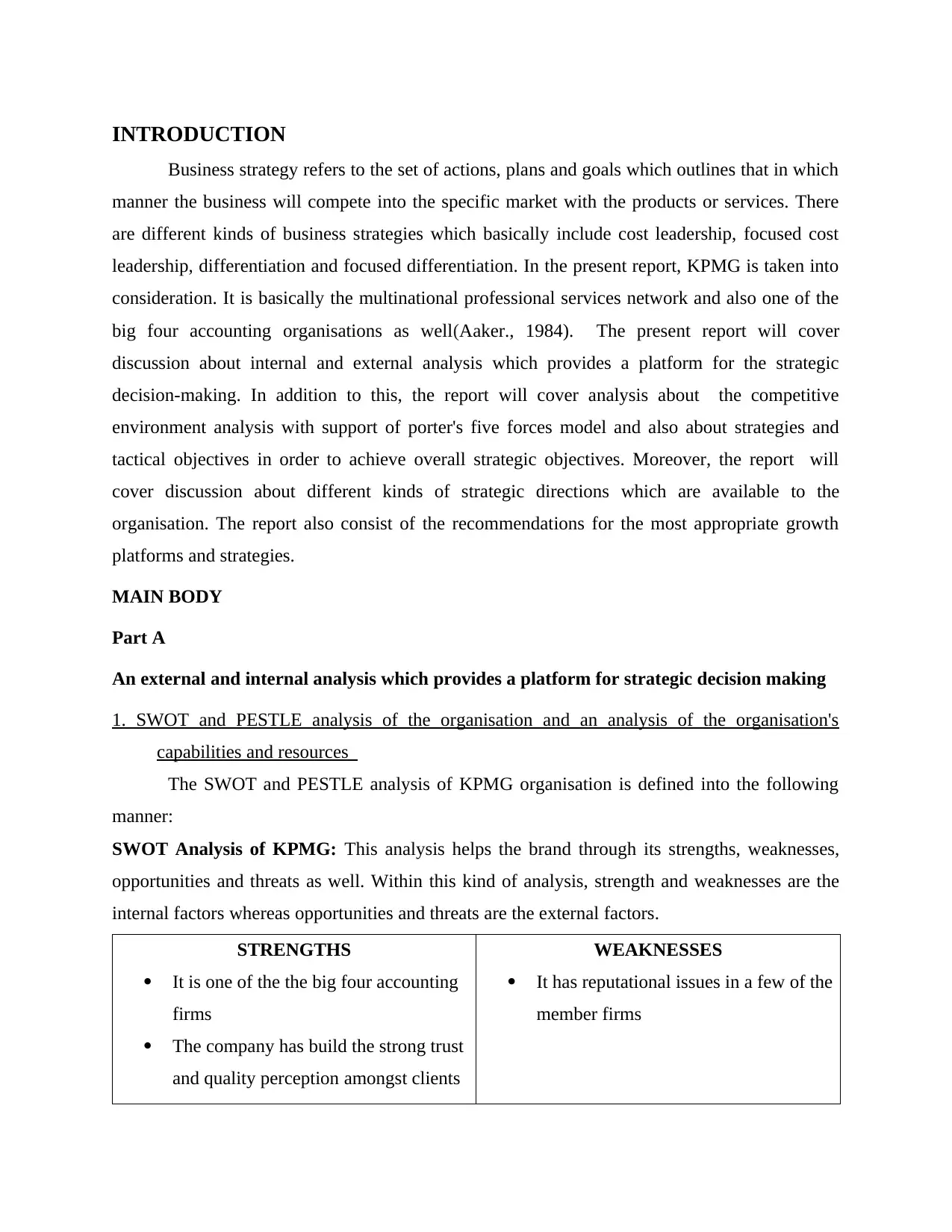
INTRODUCTION
Business strategy refers to the set of actions, plans and goals which outlines that in which
manner the business will compete into the specific market with the products or services. There
are different kinds of business strategies which basically include cost leadership, focused cost
leadership, differentiation and focused differentiation. In the present report, KPMG is taken into
consideration. It is basically the multinational professional services network and also one of the
big four accounting organisations as well(Aaker., 1984). The present report will cover
discussion about internal and external analysis which provides a platform for the strategic
decision-making. In addition to this, the report will cover analysis about the competitive
environment analysis with support of porter's five forces model and also about strategies and
tactical objectives in order to achieve overall strategic objectives. Moreover, the report will
cover discussion about different kinds of strategic directions which are available to the
organisation. The report also consist of the recommendations for the most appropriate growth
platforms and strategies.
MAIN BODY
Part A
An external and internal analysis which provides a platform for strategic decision making
1. SWOT and PESTLE analysis of the organisation and an analysis of the organisation's
capabilities and resources
The SWOT and PESTLE analysis of KPMG organisation is defined into the following
manner:
SWOT Analysis of KPMG: This analysis helps the brand through its strengths, weaknesses,
opportunities and threats as well. Within this kind of analysis, strength and weaknesses are the
internal factors whereas opportunities and threats are the external factors.
STRENGTHS
It is one of the the big four accounting
firms
The company has build the strong trust
and quality perception amongst clients
WEAKNESSES
It has reputational issues in a few of the
member firms
Business strategy refers to the set of actions, plans and goals which outlines that in which
manner the business will compete into the specific market with the products or services. There
are different kinds of business strategies which basically include cost leadership, focused cost
leadership, differentiation and focused differentiation. In the present report, KPMG is taken into
consideration. It is basically the multinational professional services network and also one of the
big four accounting organisations as well(Aaker., 1984). The present report will cover
discussion about internal and external analysis which provides a platform for the strategic
decision-making. In addition to this, the report will cover analysis about the competitive
environment analysis with support of porter's five forces model and also about strategies and
tactical objectives in order to achieve overall strategic objectives. Moreover, the report will
cover discussion about different kinds of strategic directions which are available to the
organisation. The report also consist of the recommendations for the most appropriate growth
platforms and strategies.
MAIN BODY
Part A
An external and internal analysis which provides a platform for strategic decision making
1. SWOT and PESTLE analysis of the organisation and an analysis of the organisation's
capabilities and resources
The SWOT and PESTLE analysis of KPMG organisation is defined into the following
manner:
SWOT Analysis of KPMG: This analysis helps the brand through its strengths, weaknesses,
opportunities and threats as well. Within this kind of analysis, strength and weaknesses are the
internal factors whereas opportunities and threats are the external factors.
STRENGTHS
It is one of the the big four accounting
firms
The company has build the strong trust
and quality perception amongst clients
WEAKNESSES
It has reputational issues in a few of the
member firms
⊘ This is a preview!⊘
Do you want full access?
Subscribe today to unlock all pages.

Trusted by 1+ million students worldwide
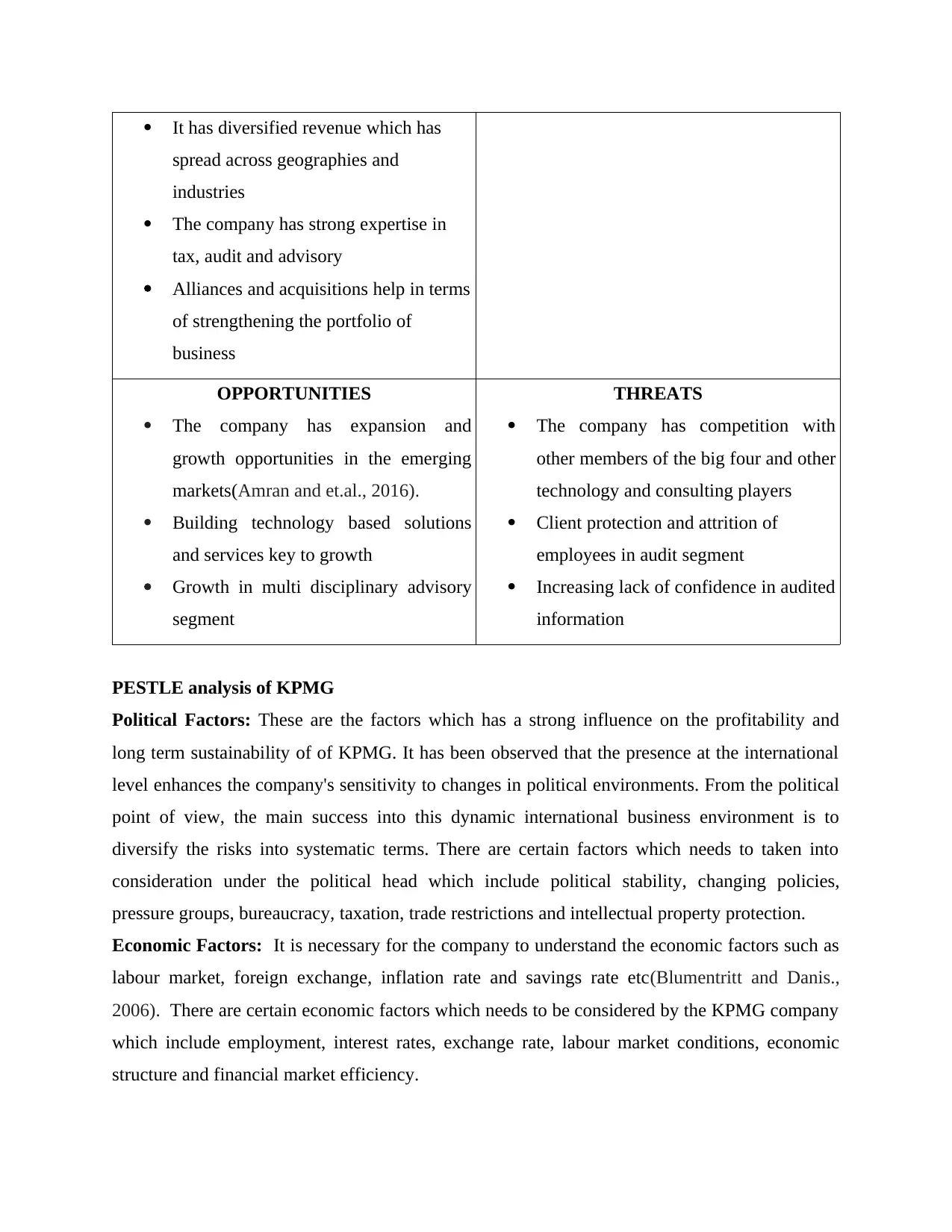
It has diversified revenue which has
spread across geographies and
industries
The company has strong expertise in
tax, audit and advisory
Alliances and acquisitions help in terms
of strengthening the portfolio of
business
OPPORTUNITIES
The company has expansion and
growth opportunities in the emerging
markets(Amran and et.al., 2016).
Building technology based solutions
and services key to growth
Growth in multi disciplinary advisory
segment
THREATS
The company has competition with
other members of the big four and other
technology and consulting players
Client protection and attrition of
employees in audit segment
Increasing lack of confidence in audited
information
PESTLE analysis of KPMG
Political Factors: These are the factors which has a strong influence on the profitability and
long term sustainability of of KPMG. It has been observed that the presence at the international
level enhances the company's sensitivity to changes in political environments. From the political
point of view, the main success into this dynamic international business environment is to
diversify the risks into systematic terms. There are certain factors which needs to taken into
consideration under the political head which include political stability, changing policies,
pressure groups, bureaucracy, taxation, trade restrictions and intellectual property protection.
Economic Factors: It is necessary for the company to understand the economic factors such as
labour market, foreign exchange, inflation rate and savings rate etc(Blumentritt and Danis.,
2006). There are certain economic factors which needs to be considered by the KPMG company
which include employment, interest rates, exchange rate, labour market conditions, economic
structure and financial market efficiency.
spread across geographies and
industries
The company has strong expertise in
tax, audit and advisory
Alliances and acquisitions help in terms
of strengthening the portfolio of
business
OPPORTUNITIES
The company has expansion and
growth opportunities in the emerging
markets(Amran and et.al., 2016).
Building technology based solutions
and services key to growth
Growth in multi disciplinary advisory
segment
THREATS
The company has competition with
other members of the big four and other
technology and consulting players
Client protection and attrition of
employees in audit segment
Increasing lack of confidence in audited
information
PESTLE analysis of KPMG
Political Factors: These are the factors which has a strong influence on the profitability and
long term sustainability of of KPMG. It has been observed that the presence at the international
level enhances the company's sensitivity to changes in political environments. From the political
point of view, the main success into this dynamic international business environment is to
diversify the risks into systematic terms. There are certain factors which needs to taken into
consideration under the political head which include political stability, changing policies,
pressure groups, bureaucracy, taxation, trade restrictions and intellectual property protection.
Economic Factors: It is necessary for the company to understand the economic factors such as
labour market, foreign exchange, inflation rate and savings rate etc(Blumentritt and Danis.,
2006). There are certain economic factors which needs to be considered by the KPMG company
which include employment, interest rates, exchange rate, labour market conditions, economic
structure and financial market efficiency.
Paraphrase This Document
Need a fresh take? Get an instant paraphrase of this document with our AI Paraphraser
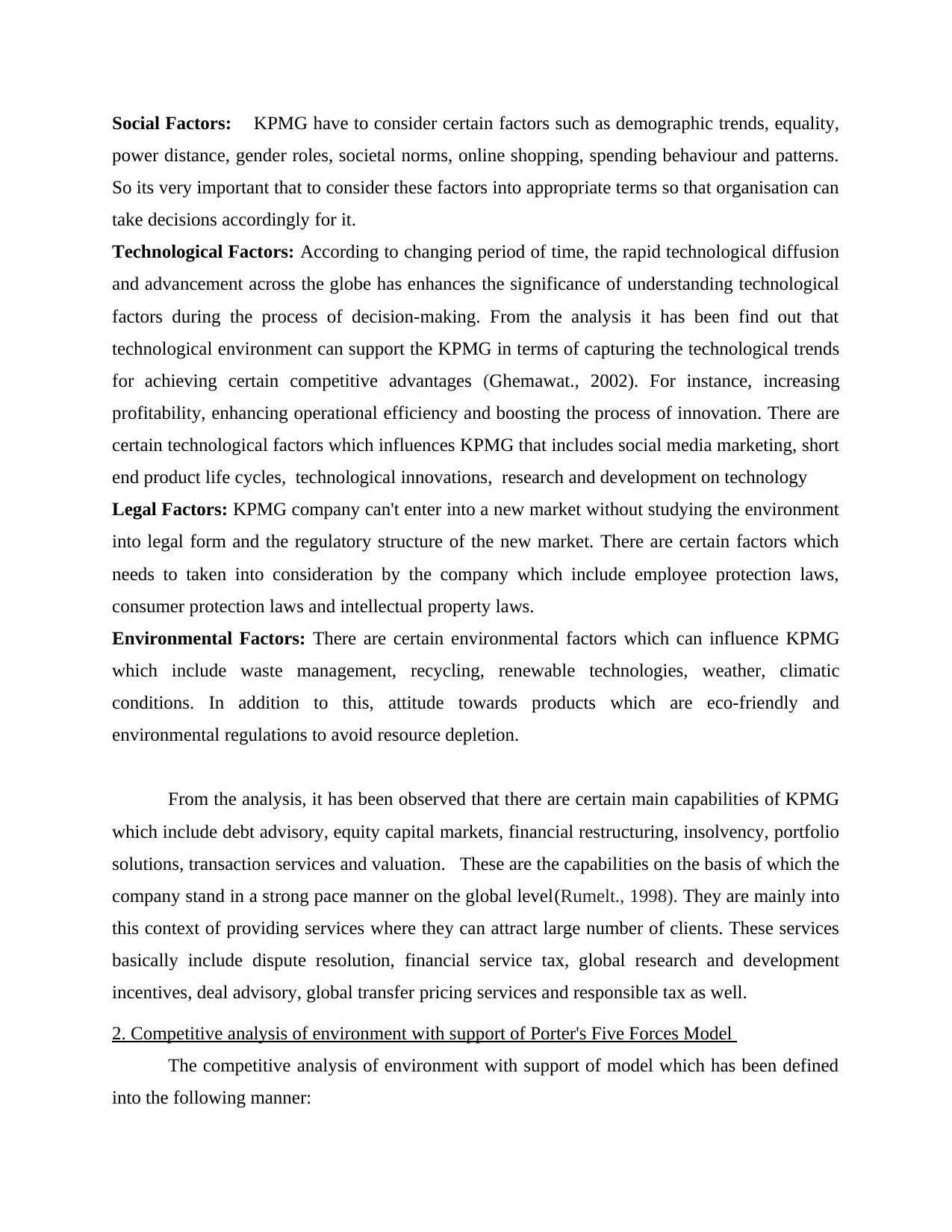
Social Factors: KPMG have to consider certain factors such as demographic trends, equality,
power distance, gender roles, societal norms, online shopping, spending behaviour and patterns.
So its very important that to consider these factors into appropriate terms so that organisation can
take decisions accordingly for it.
Technological Factors: According to changing period of time, the rapid technological diffusion
and advancement across the globe has enhances the significance of understanding technological
factors during the process of decision-making. From the analysis it has been find out that
technological environment can support the KPMG in terms of capturing the technological trends
for achieving certain competitive advantages (Ghemawat., 2002). For instance, increasing
profitability, enhancing operational efficiency and boosting the process of innovation. There are
certain technological factors which influences KPMG that includes social media marketing, short
end product life cycles, technological innovations, research and development on technology
Legal Factors: KPMG company can't enter into a new market without studying the environment
into legal form and the regulatory structure of the new market. There are certain factors which
needs to taken into consideration by the company which include employee protection laws,
consumer protection laws and intellectual property laws.
Environmental Factors: There are certain environmental factors which can influence KPMG
which include waste management, recycling, renewable technologies, weather, climatic
conditions. In addition to this, attitude towards products which are eco-friendly and
environmental regulations to avoid resource depletion.
From the analysis, it has been observed that there are certain main capabilities of KPMG
which include debt advisory, equity capital markets, financial restructuring, insolvency, portfolio
solutions, transaction services and valuation. These are the capabilities on the basis of which the
company stand in a strong pace manner on the global level(Rumelt., 1998). They are mainly into
this context of providing services where they can attract large number of clients. These services
basically include dispute resolution, financial service tax, global research and development
incentives, deal advisory, global transfer pricing services and responsible tax as well.
2. Competitive analysis of environment with support of Porter's Five Forces Model
The competitive analysis of environment with support of model which has been defined
into the following manner:
power distance, gender roles, societal norms, online shopping, spending behaviour and patterns.
So its very important that to consider these factors into appropriate terms so that organisation can
take decisions accordingly for it.
Technological Factors: According to changing period of time, the rapid technological diffusion
and advancement across the globe has enhances the significance of understanding technological
factors during the process of decision-making. From the analysis it has been find out that
technological environment can support the KPMG in terms of capturing the technological trends
for achieving certain competitive advantages (Ghemawat., 2002). For instance, increasing
profitability, enhancing operational efficiency and boosting the process of innovation. There are
certain technological factors which influences KPMG that includes social media marketing, short
end product life cycles, technological innovations, research and development on technology
Legal Factors: KPMG company can't enter into a new market without studying the environment
into legal form and the regulatory structure of the new market. There are certain factors which
needs to taken into consideration by the company which include employee protection laws,
consumer protection laws and intellectual property laws.
Environmental Factors: There are certain environmental factors which can influence KPMG
which include waste management, recycling, renewable technologies, weather, climatic
conditions. In addition to this, attitude towards products which are eco-friendly and
environmental regulations to avoid resource depletion.
From the analysis, it has been observed that there are certain main capabilities of KPMG
which include debt advisory, equity capital markets, financial restructuring, insolvency, portfolio
solutions, transaction services and valuation. These are the capabilities on the basis of which the
company stand in a strong pace manner on the global level(Rumelt., 1998). They are mainly into
this context of providing services where they can attract large number of clients. These services
basically include dispute resolution, financial service tax, global research and development
incentives, deal advisory, global transfer pricing services and responsible tax as well.
2. Competitive analysis of environment with support of Porter's Five Forces Model
The competitive analysis of environment with support of model which has been defined
into the following manner:
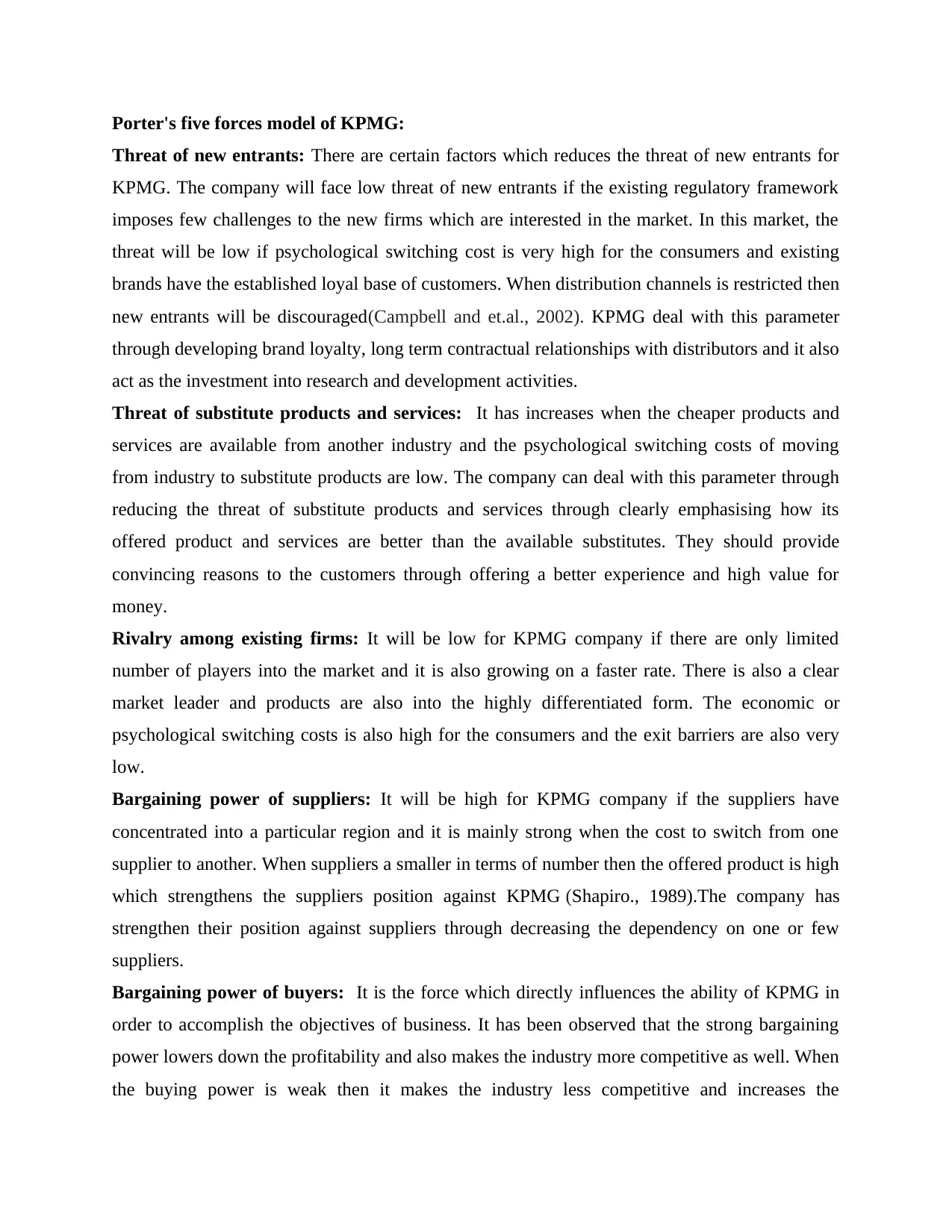
Porter's five forces model of KPMG:
Threat of new entrants: There are certain factors which reduces the threat of new entrants for
KPMG. The company will face low threat of new entrants if the existing regulatory framework
imposes few challenges to the new firms which are interested in the market. In this market, the
threat will be low if psychological switching cost is very high for the consumers and existing
brands have the established loyal base of customers. When distribution channels is restricted then
new entrants will be discouraged(Campbell and et.al., 2002). KPMG deal with this parameter
through developing brand loyalty, long term contractual relationships with distributors and it also
act as the investment into research and development activities.
Threat of substitute products and services: It has increases when the cheaper products and
services are available from another industry and the psychological switching costs of moving
from industry to substitute products are low. The company can deal with this parameter through
reducing the threat of substitute products and services through clearly emphasising how its
offered product and services are better than the available substitutes. They should provide
convincing reasons to the customers through offering a better experience and high value for
money.
Rivalry among existing firms: It will be low for KPMG company if there are only limited
number of players into the market and it is also growing on a faster rate. There is also a clear
market leader and products are also into the highly differentiated form. The economic or
psychological switching costs is also high for the consumers and the exit barriers are also very
low.
Bargaining power of suppliers: It will be high for KPMG company if the suppliers have
concentrated into a particular region and it is mainly strong when the cost to switch from one
supplier to another. When suppliers a smaller in terms of number then the offered product is high
which strengthens the suppliers position against KPMG (Shapiro., 1989).The company has
strengthen their position against suppliers through decreasing the dependency on one or few
suppliers.
Bargaining power of buyers: It is the force which directly influences the ability of KPMG in
order to accomplish the objectives of business. It has been observed that the strong bargaining
power lowers down the profitability and also makes the industry more competitive as well. When
the buying power is weak then it makes the industry less competitive and increases the
Threat of new entrants: There are certain factors which reduces the threat of new entrants for
KPMG. The company will face low threat of new entrants if the existing regulatory framework
imposes few challenges to the new firms which are interested in the market. In this market, the
threat will be low if psychological switching cost is very high for the consumers and existing
brands have the established loyal base of customers. When distribution channels is restricted then
new entrants will be discouraged(Campbell and et.al., 2002). KPMG deal with this parameter
through developing brand loyalty, long term contractual relationships with distributors and it also
act as the investment into research and development activities.
Threat of substitute products and services: It has increases when the cheaper products and
services are available from another industry and the psychological switching costs of moving
from industry to substitute products are low. The company can deal with this parameter through
reducing the threat of substitute products and services through clearly emphasising how its
offered product and services are better than the available substitutes. They should provide
convincing reasons to the customers through offering a better experience and high value for
money.
Rivalry among existing firms: It will be low for KPMG company if there are only limited
number of players into the market and it is also growing on a faster rate. There is also a clear
market leader and products are also into the highly differentiated form. The economic or
psychological switching costs is also high for the consumers and the exit barriers are also very
low.
Bargaining power of suppliers: It will be high for KPMG company if the suppliers have
concentrated into a particular region and it is mainly strong when the cost to switch from one
supplier to another. When suppliers a smaller in terms of number then the offered product is high
which strengthens the suppliers position against KPMG (Shapiro., 1989).The company has
strengthen their position against suppliers through decreasing the dependency on one or few
suppliers.
Bargaining power of buyers: It is the force which directly influences the ability of KPMG in
order to accomplish the objectives of business. It has been observed that the strong bargaining
power lowers down the profitability and also makes the industry more competitive as well. When
the buying power is weak then it makes the industry less competitive and increases the
⊘ This is a preview!⊘
Do you want full access?
Subscribe today to unlock all pages.

Trusted by 1+ million students worldwide
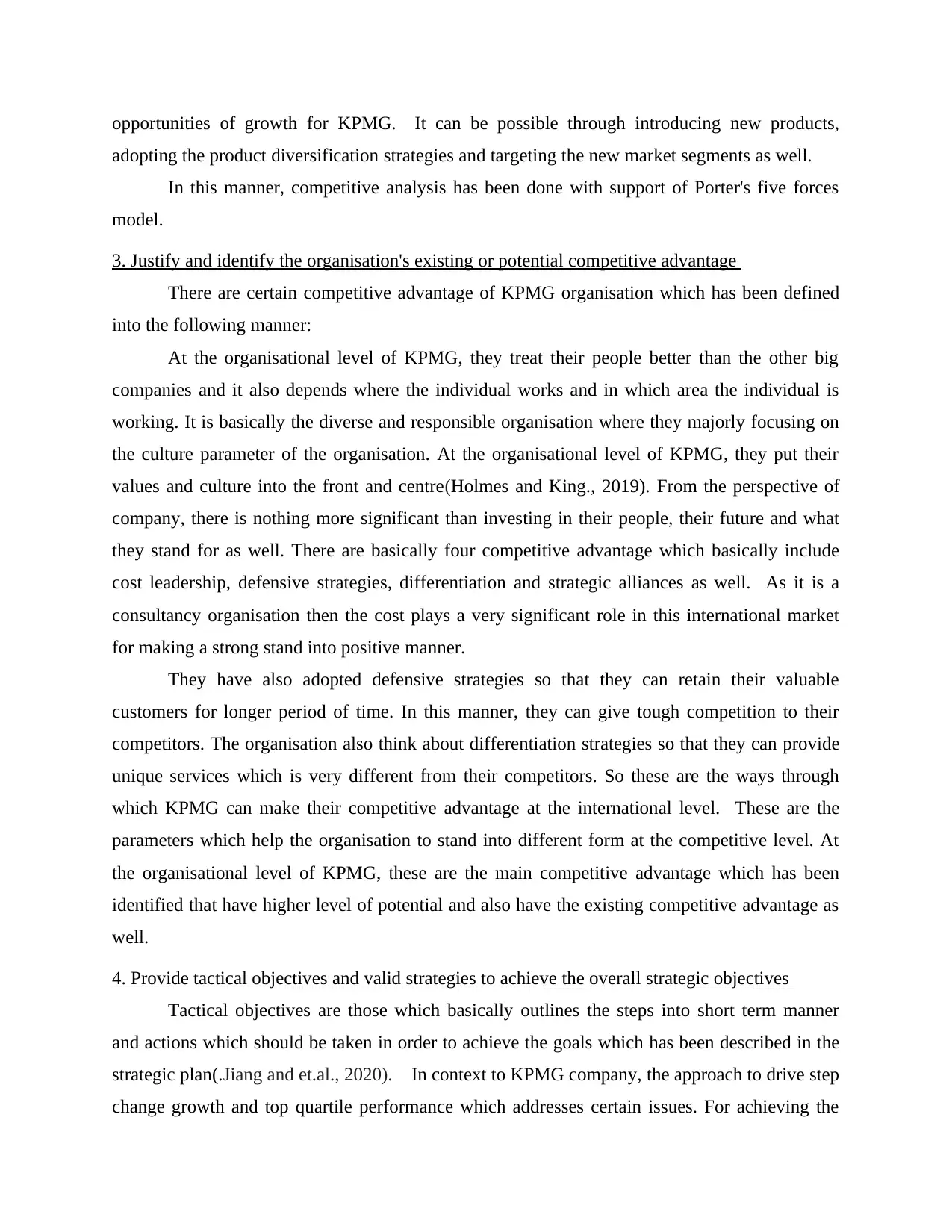
opportunities of growth for KPMG. It can be possible through introducing new products,
adopting the product diversification strategies and targeting the new market segments as well.
In this manner, competitive analysis has been done with support of Porter's five forces
model.
3. Justify and identify the organisation's existing or potential competitive advantage
There are certain competitive advantage of KPMG organisation which has been defined
into the following manner:
At the organisational level of KPMG, they treat their people better than the other big
companies and it also depends where the individual works and in which area the individual is
working. It is basically the diverse and responsible organisation where they majorly focusing on
the culture parameter of the organisation. At the organisational level of KPMG, they put their
values and culture into the front and centre(Holmes and King., 2019). From the perspective of
company, there is nothing more significant than investing in their people, their future and what
they stand for as well. There are basically four competitive advantage which basically include
cost leadership, defensive strategies, differentiation and strategic alliances as well. As it is a
consultancy organisation then the cost plays a very significant role in this international market
for making a strong stand into positive manner.
They have also adopted defensive strategies so that they can retain their valuable
customers for longer period of time. In this manner, they can give tough competition to their
competitors. The organisation also think about differentiation strategies so that they can provide
unique services which is very different from their competitors. So these are the ways through
which KPMG can make their competitive advantage at the international level. These are the
parameters which help the organisation to stand into different form at the competitive level. At
the organisational level of KPMG, these are the main competitive advantage which has been
identified that have higher level of potential and also have the existing competitive advantage as
well.
4. Provide tactical objectives and valid strategies to achieve the overall strategic objectives
Tactical objectives are those which basically outlines the steps into short term manner
and actions which should be taken in order to achieve the goals which has been described in the
strategic plan(.Jiang and et.al., 2020). In context to KPMG company, the approach to drive step
change growth and top quartile performance which addresses certain issues. For achieving the
adopting the product diversification strategies and targeting the new market segments as well.
In this manner, competitive analysis has been done with support of Porter's five forces
model.
3. Justify and identify the organisation's existing or potential competitive advantage
There are certain competitive advantage of KPMG organisation which has been defined
into the following manner:
At the organisational level of KPMG, they treat their people better than the other big
companies and it also depends where the individual works and in which area the individual is
working. It is basically the diverse and responsible organisation where they majorly focusing on
the culture parameter of the organisation. At the organisational level of KPMG, they put their
values and culture into the front and centre(Holmes and King., 2019). From the perspective of
company, there is nothing more significant than investing in their people, their future and what
they stand for as well. There are basically four competitive advantage which basically include
cost leadership, defensive strategies, differentiation and strategic alliances as well. As it is a
consultancy organisation then the cost plays a very significant role in this international market
for making a strong stand into positive manner.
They have also adopted defensive strategies so that they can retain their valuable
customers for longer period of time. In this manner, they can give tough competition to their
competitors. The organisation also think about differentiation strategies so that they can provide
unique services which is very different from their competitors. So these are the ways through
which KPMG can make their competitive advantage at the international level. These are the
parameters which help the organisation to stand into different form at the competitive level. At
the organisational level of KPMG, these are the main competitive advantage which has been
identified that have higher level of potential and also have the existing competitive advantage as
well.
4. Provide tactical objectives and valid strategies to achieve the overall strategic objectives
Tactical objectives are those which basically outlines the steps into short term manner
and actions which should be taken in order to achieve the goals which has been described in the
strategic plan(.Jiang and et.al., 2020). In context to KPMG company, the approach to drive step
change growth and top quartile performance which addresses certain issues. For achieving the
Paraphrase This Document
Need a fresh take? Get an instant paraphrase of this document with our AI Paraphraser
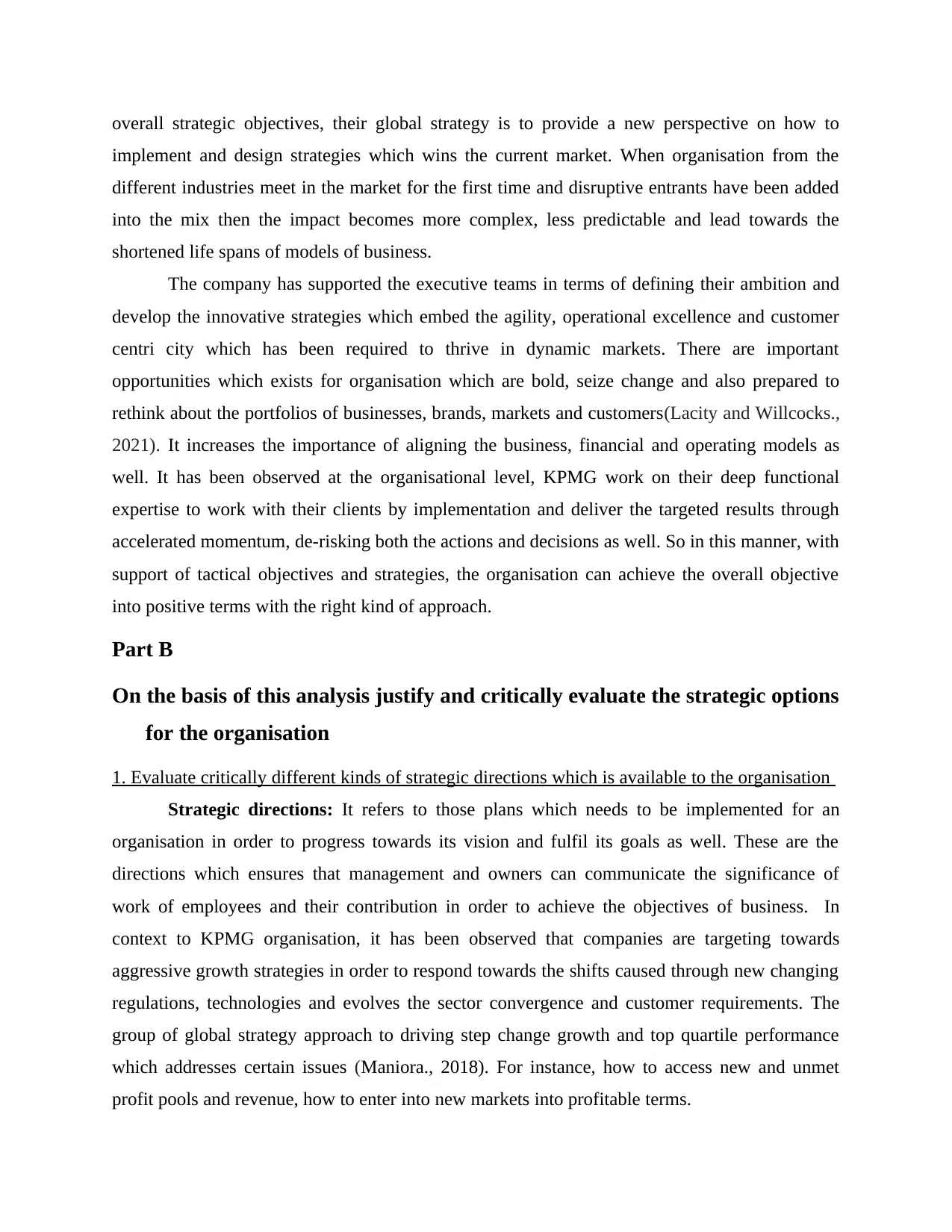
overall strategic objectives, their global strategy is to provide a new perspective on how to
implement and design strategies which wins the current market. When organisation from the
different industries meet in the market for the first time and disruptive entrants have been added
into the mix then the impact becomes more complex, less predictable and lead towards the
shortened life spans of models of business.
The company has supported the executive teams in terms of defining their ambition and
develop the innovative strategies which embed the agility, operational excellence and customer
centri city which has been required to thrive in dynamic markets. There are important
opportunities which exists for organisation which are bold, seize change and also prepared to
rethink about the portfolios of businesses, brands, markets and customers(Lacity and Willcocks.,
2021). It increases the importance of aligning the business, financial and operating models as
well. It has been observed at the organisational level, KPMG work on their deep functional
expertise to work with their clients by implementation and deliver the targeted results through
accelerated momentum, de-risking both the actions and decisions as well. So in this manner, with
support of tactical objectives and strategies, the organisation can achieve the overall objective
into positive terms with the right kind of approach.
Part B
On the basis of this analysis justify and critically evaluate the strategic options
for the organisation
1. Evaluate critically different kinds of strategic directions which is available to the organisation
Strategic directions: It refers to those plans which needs to be implemented for an
organisation in order to progress towards its vision and fulfil its goals as well. These are the
directions which ensures that management and owners can communicate the significance of
work of employees and their contribution in order to achieve the objectives of business. In
context to KPMG organisation, it has been observed that companies are targeting towards
aggressive growth strategies in order to respond towards the shifts caused through new changing
regulations, technologies and evolves the sector convergence and customer requirements. The
group of global strategy approach to driving step change growth and top quartile performance
which addresses certain issues (Maniora., 2018). For instance, how to access new and unmet
profit pools and revenue, how to enter into new markets into profitable terms.
implement and design strategies which wins the current market. When organisation from the
different industries meet in the market for the first time and disruptive entrants have been added
into the mix then the impact becomes more complex, less predictable and lead towards the
shortened life spans of models of business.
The company has supported the executive teams in terms of defining their ambition and
develop the innovative strategies which embed the agility, operational excellence and customer
centri city which has been required to thrive in dynamic markets. There are important
opportunities which exists for organisation which are bold, seize change and also prepared to
rethink about the portfolios of businesses, brands, markets and customers(Lacity and Willcocks.,
2021). It increases the importance of aligning the business, financial and operating models as
well. It has been observed at the organisational level, KPMG work on their deep functional
expertise to work with their clients by implementation and deliver the targeted results through
accelerated momentum, de-risking both the actions and decisions as well. So in this manner, with
support of tactical objectives and strategies, the organisation can achieve the overall objective
into positive terms with the right kind of approach.
Part B
On the basis of this analysis justify and critically evaluate the strategic options
for the organisation
1. Evaluate critically different kinds of strategic directions which is available to the organisation
Strategic directions: It refers to those plans which needs to be implemented for an
organisation in order to progress towards its vision and fulfil its goals as well. These are the
directions which ensures that management and owners can communicate the significance of
work of employees and their contribution in order to achieve the objectives of business. In
context to KPMG organisation, it has been observed that companies are targeting towards
aggressive growth strategies in order to respond towards the shifts caused through new changing
regulations, technologies and evolves the sector convergence and customer requirements. The
group of global strategy approach to driving step change growth and top quartile performance
which addresses certain issues (Maniora., 2018). For instance, how to access new and unmet
profit pools and revenue, how to enter into new markets into profitable terms.
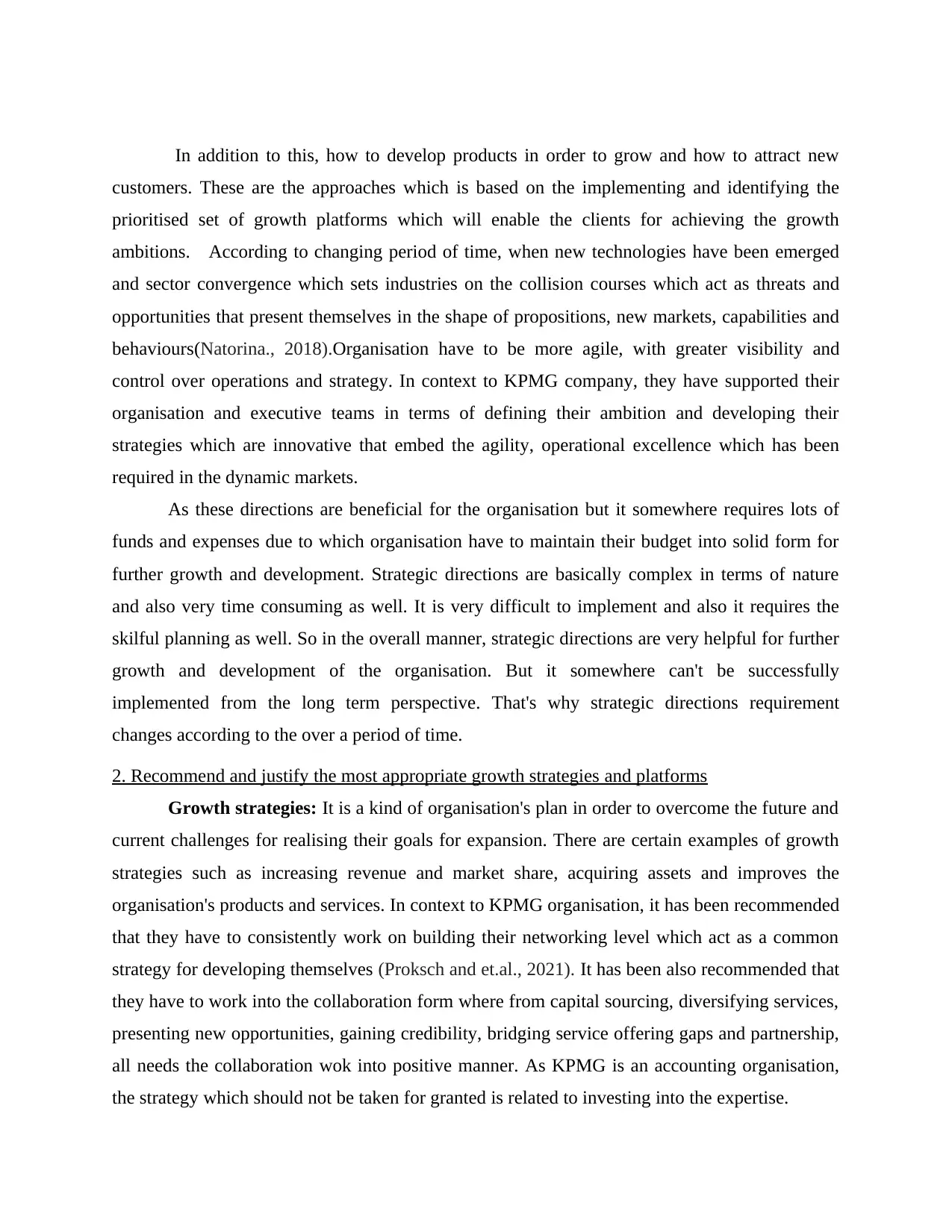
In addition to this, how to develop products in order to grow and how to attract new
customers. These are the approaches which is based on the implementing and identifying the
prioritised set of growth platforms which will enable the clients for achieving the growth
ambitions. According to changing period of time, when new technologies have been emerged
and sector convergence which sets industries on the collision courses which act as threats and
opportunities that present themselves in the shape of propositions, new markets, capabilities and
behaviours(Natorina., 2018).Organisation have to be more agile, with greater visibility and
control over operations and strategy. In context to KPMG company, they have supported their
organisation and executive teams in terms of defining their ambition and developing their
strategies which are innovative that embed the agility, operational excellence which has been
required in the dynamic markets.
As these directions are beneficial for the organisation but it somewhere requires lots of
funds and expenses due to which organisation have to maintain their budget into solid form for
further growth and development. Strategic directions are basically complex in terms of nature
and also very time consuming as well. It is very difficult to implement and also it requires the
skilful planning as well. So in the overall manner, strategic directions are very helpful for further
growth and development of the organisation. But it somewhere can't be successfully
implemented from the long term perspective. That's why strategic directions requirement
changes according to the over a period of time.
2. Recommend and justify the most appropriate growth strategies and platforms
Growth strategies: It is a kind of organisation's plan in order to overcome the future and
current challenges for realising their goals for expansion. There are certain examples of growth
strategies such as increasing revenue and market share, acquiring assets and improves the
organisation's products and services. In context to KPMG organisation, it has been recommended
that they have to consistently work on building their networking level which act as a common
strategy for developing themselves (Proksch and et.al., 2021). It has been also recommended that
they have to work into the collaboration form where from capital sourcing, diversifying services,
presenting new opportunities, gaining credibility, bridging service offering gaps and partnership,
all needs the collaboration wok into positive manner. As KPMG is an accounting organisation,
the strategy which should not be taken for granted is related to investing into the expertise.
customers. These are the approaches which is based on the implementing and identifying the
prioritised set of growth platforms which will enable the clients for achieving the growth
ambitions. According to changing period of time, when new technologies have been emerged
and sector convergence which sets industries on the collision courses which act as threats and
opportunities that present themselves in the shape of propositions, new markets, capabilities and
behaviours(Natorina., 2018).Organisation have to be more agile, with greater visibility and
control over operations and strategy. In context to KPMG company, they have supported their
organisation and executive teams in terms of defining their ambition and developing their
strategies which are innovative that embed the agility, operational excellence which has been
required in the dynamic markets.
As these directions are beneficial for the organisation but it somewhere requires lots of
funds and expenses due to which organisation have to maintain their budget into solid form for
further growth and development. Strategic directions are basically complex in terms of nature
and also very time consuming as well. It is very difficult to implement and also it requires the
skilful planning as well. So in the overall manner, strategic directions are very helpful for further
growth and development of the organisation. But it somewhere can't be successfully
implemented from the long term perspective. That's why strategic directions requirement
changes according to the over a period of time.
2. Recommend and justify the most appropriate growth strategies and platforms
Growth strategies: It is a kind of organisation's plan in order to overcome the future and
current challenges for realising their goals for expansion. There are certain examples of growth
strategies such as increasing revenue and market share, acquiring assets and improves the
organisation's products and services. In context to KPMG organisation, it has been recommended
that they have to consistently work on building their networking level which act as a common
strategy for developing themselves (Proksch and et.al., 2021). It has been also recommended that
they have to work into the collaboration form where from capital sourcing, diversifying services,
presenting new opportunities, gaining credibility, bridging service offering gaps and partnership,
all needs the collaboration wok into positive manner. As KPMG is an accounting organisation,
the strategy which should not be taken for granted is related to investing into the expertise.
⊘ This is a preview!⊘
Do you want full access?
Subscribe today to unlock all pages.

Trusted by 1+ million students worldwide
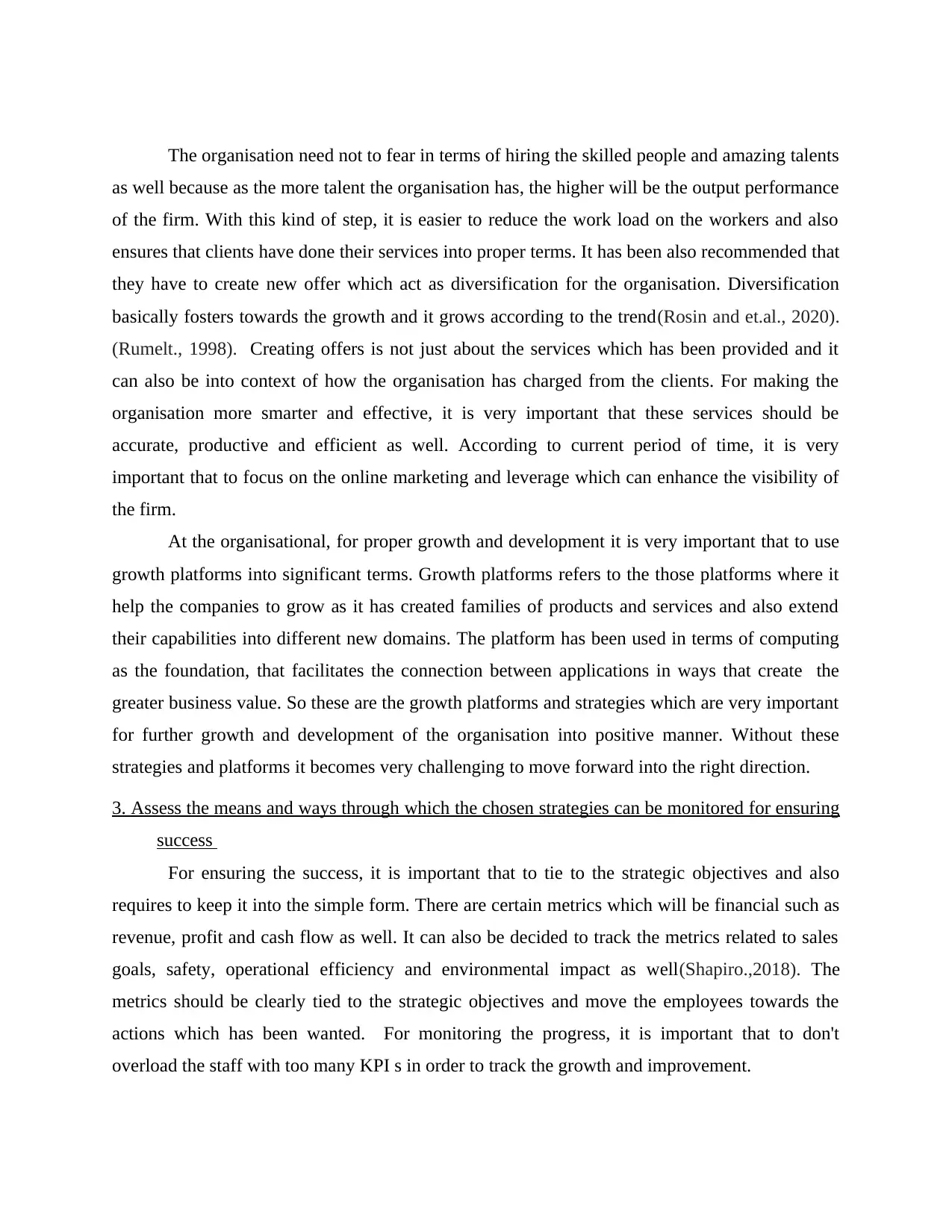
The organisation need not to fear in terms of hiring the skilled people and amazing talents
as well because as the more talent the organisation has, the higher will be the output performance
of the firm. With this kind of step, it is easier to reduce the work load on the workers and also
ensures that clients have done their services into proper terms. It has been also recommended that
they have to create new offer which act as diversification for the organisation. Diversification
basically fosters towards the growth and it grows according to the trend(Rosin and et.al., 2020).
(Rumelt., 1998). Creating offers is not just about the services which has been provided and it
can also be into context of how the organisation has charged from the clients. For making the
organisation more smarter and effective, it is very important that these services should be
accurate, productive and efficient as well. According to current period of time, it is very
important that to focus on the online marketing and leverage which can enhance the visibility of
the firm.
At the organisational, for proper growth and development it is very important that to use
growth platforms into significant terms. Growth platforms refers to the those platforms where it
help the companies to grow as it has created families of products and services and also extend
their capabilities into different new domains. The platform has been used in terms of computing
as the foundation, that facilitates the connection between applications in ways that create the
greater business value. So these are the growth platforms and strategies which are very important
for further growth and development of the organisation into positive manner. Without these
strategies and platforms it becomes very challenging to move forward into the right direction.
3. Assess the means and ways through which the chosen strategies can be monitored for ensuring
success
For ensuring the success, it is important that to tie to the strategic objectives and also
requires to keep it into the simple form. There are certain metrics which will be financial such as
revenue, profit and cash flow as well. It can also be decided to track the metrics related to sales
goals, safety, operational efficiency and environmental impact as well(Shapiro.,2018). The
metrics should be clearly tied to the strategic objectives and move the employees towards the
actions which has been wanted. For monitoring the progress, it is important that to don't
overload the staff with too many KPI s in order to track the growth and improvement.
as well because as the more talent the organisation has, the higher will be the output performance
of the firm. With this kind of step, it is easier to reduce the work load on the workers and also
ensures that clients have done their services into proper terms. It has been also recommended that
they have to create new offer which act as diversification for the organisation. Diversification
basically fosters towards the growth and it grows according to the trend(Rosin and et.al., 2020).
(Rumelt., 1998). Creating offers is not just about the services which has been provided and it
can also be into context of how the organisation has charged from the clients. For making the
organisation more smarter and effective, it is very important that these services should be
accurate, productive and efficient as well. According to current period of time, it is very
important that to focus on the online marketing and leverage which can enhance the visibility of
the firm.
At the organisational, for proper growth and development it is very important that to use
growth platforms into significant terms. Growth platforms refers to the those platforms where it
help the companies to grow as it has created families of products and services and also extend
their capabilities into different new domains. The platform has been used in terms of computing
as the foundation, that facilitates the connection between applications in ways that create the
greater business value. So these are the growth platforms and strategies which are very important
for further growth and development of the organisation into positive manner. Without these
strategies and platforms it becomes very challenging to move forward into the right direction.
3. Assess the means and ways through which the chosen strategies can be monitored for ensuring
success
For ensuring the success, it is important that to tie to the strategic objectives and also
requires to keep it into the simple form. There are certain metrics which will be financial such as
revenue, profit and cash flow as well. It can also be decided to track the metrics related to sales
goals, safety, operational efficiency and environmental impact as well(Shapiro.,2018). The
metrics should be clearly tied to the strategic objectives and move the employees towards the
actions which has been wanted. For monitoring the progress, it is important that to don't
overload the staff with too many KPI s in order to track the growth and improvement.
Paraphrase This Document
Need a fresh take? Get an instant paraphrase of this document with our AI Paraphraser
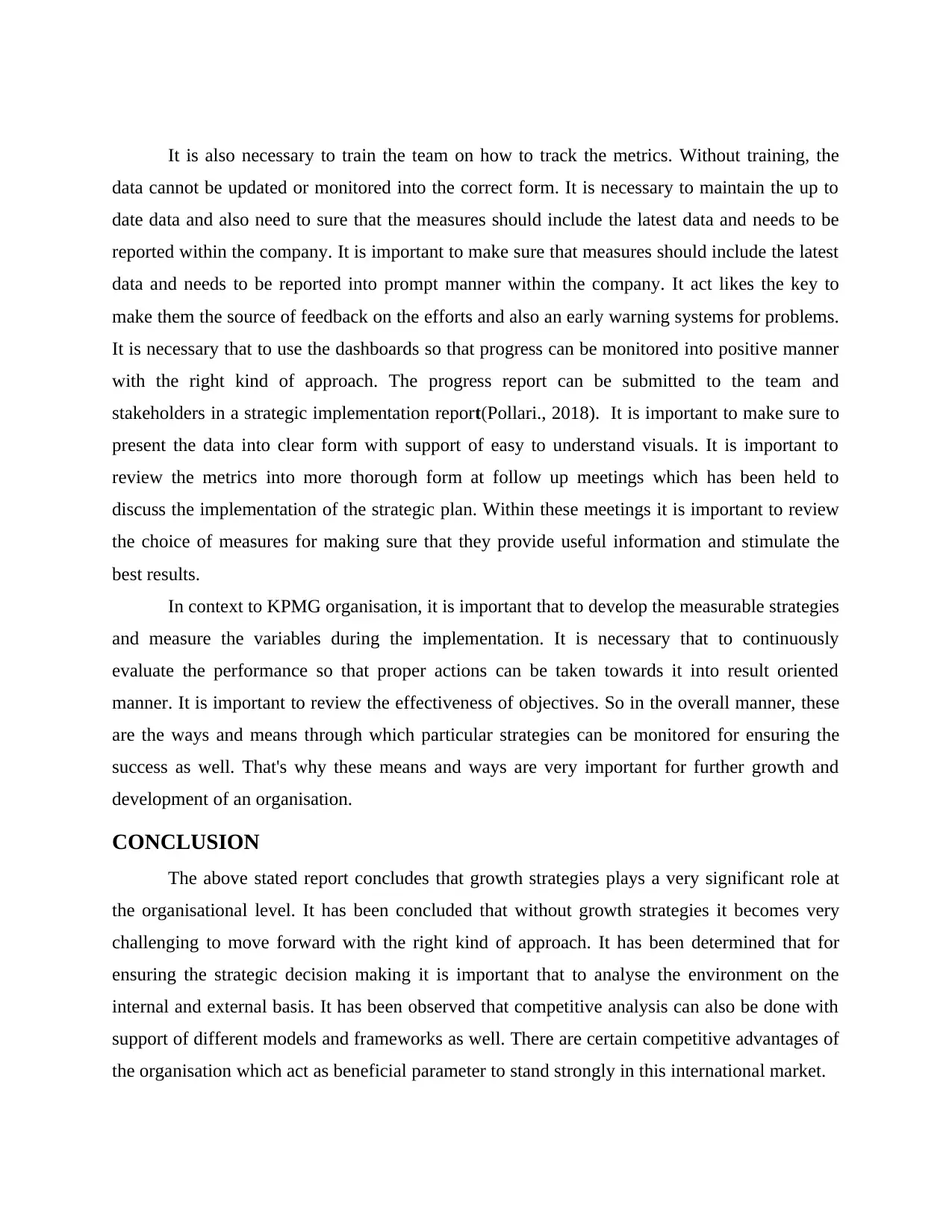
It is also necessary to train the team on how to track the metrics. Without training, the
data cannot be updated or monitored into the correct form. It is necessary to maintain the up to
date data and also need to sure that the measures should include the latest data and needs to be
reported within the company. It is important to make sure that measures should include the latest
data and needs to be reported into prompt manner within the company. It act likes the key to
make them the source of feedback on the efforts and also an early warning systems for problems.
It is necessary that to use the dashboards so that progress can be monitored into positive manner
with the right kind of approach. The progress report can be submitted to the team and
stakeholders in a strategic implementation report(Pollari., 2018). It is important to make sure to
present the data into clear form with support of easy to understand visuals. It is important to
review the metrics into more thorough form at follow up meetings which has been held to
discuss the implementation of the strategic plan. Within these meetings it is important to review
the choice of measures for making sure that they provide useful information and stimulate the
best results.
In context to KPMG organisation, it is important that to develop the measurable strategies
and measure the variables during the implementation. It is necessary that to continuously
evaluate the performance so that proper actions can be taken towards it into result oriented
manner. It is important to review the effectiveness of objectives. So in the overall manner, these
are the ways and means through which particular strategies can be monitored for ensuring the
success as well. That's why these means and ways are very important for further growth and
development of an organisation.
CONCLUSION
The above stated report concludes that growth strategies plays a very significant role at
the organisational level. It has been concluded that without growth strategies it becomes very
challenging to move forward with the right kind of approach. It has been determined that for
ensuring the strategic decision making it is important that to analyse the environment on the
internal and external basis. It has been observed that competitive analysis can also be done with
support of different models and frameworks as well. There are certain competitive advantages of
the organisation which act as beneficial parameter to stand strongly in this international market.
data cannot be updated or monitored into the correct form. It is necessary to maintain the up to
date data and also need to sure that the measures should include the latest data and needs to be
reported within the company. It is important to make sure that measures should include the latest
data and needs to be reported into prompt manner within the company. It act likes the key to
make them the source of feedback on the efforts and also an early warning systems for problems.
It is necessary that to use the dashboards so that progress can be monitored into positive manner
with the right kind of approach. The progress report can be submitted to the team and
stakeholders in a strategic implementation report(Pollari., 2018). It is important to make sure to
present the data into clear form with support of easy to understand visuals. It is important to
review the metrics into more thorough form at follow up meetings which has been held to
discuss the implementation of the strategic plan. Within these meetings it is important to review
the choice of measures for making sure that they provide useful information and stimulate the
best results.
In context to KPMG organisation, it is important that to develop the measurable strategies
and measure the variables during the implementation. It is necessary that to continuously
evaluate the performance so that proper actions can be taken towards it into result oriented
manner. It is important to review the effectiveness of objectives. So in the overall manner, these
are the ways and means through which particular strategies can be monitored for ensuring the
success as well. That's why these means and ways are very important for further growth and
development of an organisation.
CONCLUSION
The above stated report concludes that growth strategies plays a very significant role at
the organisational level. It has been concluded that without growth strategies it becomes very
challenging to move forward with the right kind of approach. It has been determined that for
ensuring the strategic decision making it is important that to analyse the environment on the
internal and external basis. It has been observed that competitive analysis can also be done with
support of different models and frameworks as well. There are certain competitive advantages of
the organisation which act as beneficial parameter to stand strongly in this international market.
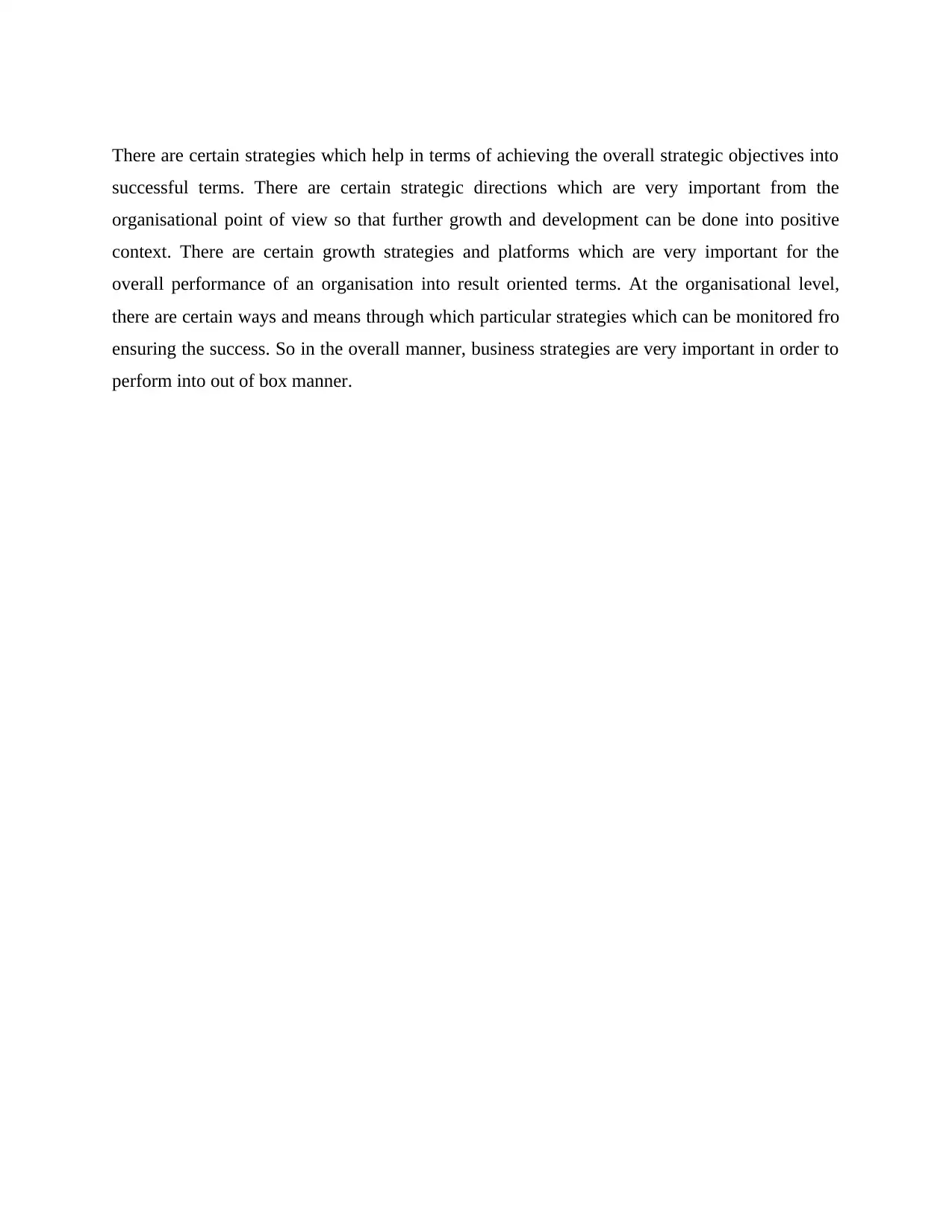
There are certain strategies which help in terms of achieving the overall strategic objectives into
successful terms. There are certain strategic directions which are very important from the
organisational point of view so that further growth and development can be done into positive
context. There are certain growth strategies and platforms which are very important for the
overall performance of an organisation into result oriented terms. At the organisational level,
there are certain ways and means through which particular strategies which can be monitored fro
ensuring the success. So in the overall manner, business strategies are very important in order to
perform into out of box manner.
successful terms. There are certain strategic directions which are very important from the
organisational point of view so that further growth and development can be done into positive
context. There are certain growth strategies and platforms which are very important for the
overall performance of an organisation into result oriented terms. At the organisational level,
there are certain ways and means through which particular strategies which can be monitored fro
ensuring the success. So in the overall manner, business strategies are very important in order to
perform into out of box manner.
⊘ This is a preview!⊘
Do you want full access?
Subscribe today to unlock all pages.

Trusted by 1+ million students worldwide
1 out of 15
Related Documents
Your All-in-One AI-Powered Toolkit for Academic Success.
+13062052269
info@desklib.com
Available 24*7 on WhatsApp / Email
![[object Object]](/_next/static/media/star-bottom.7253800d.svg)
Unlock your academic potential
Copyright © 2020–2025 A2Z Services. All Rights Reserved. Developed and managed by ZUCOL.





